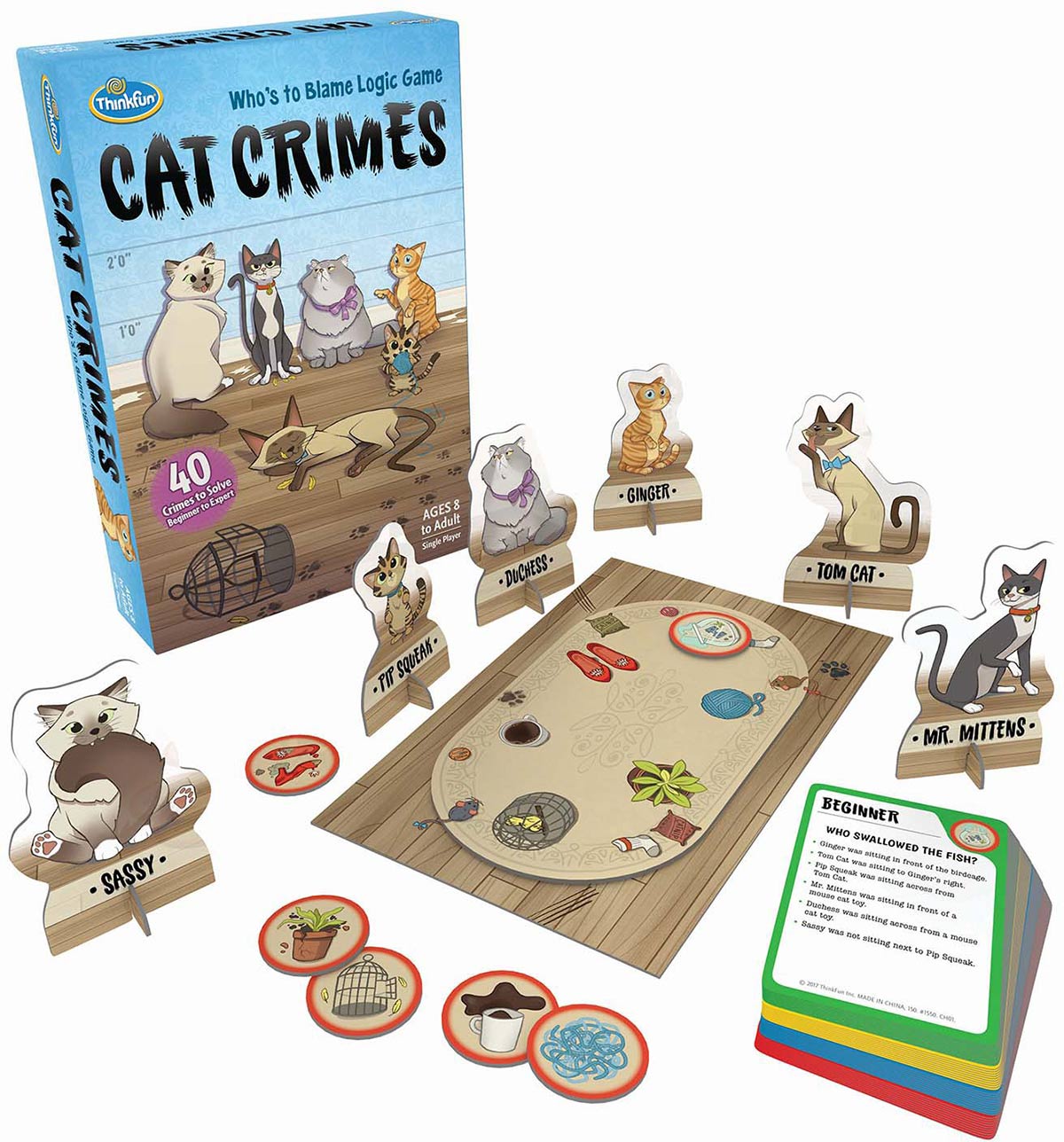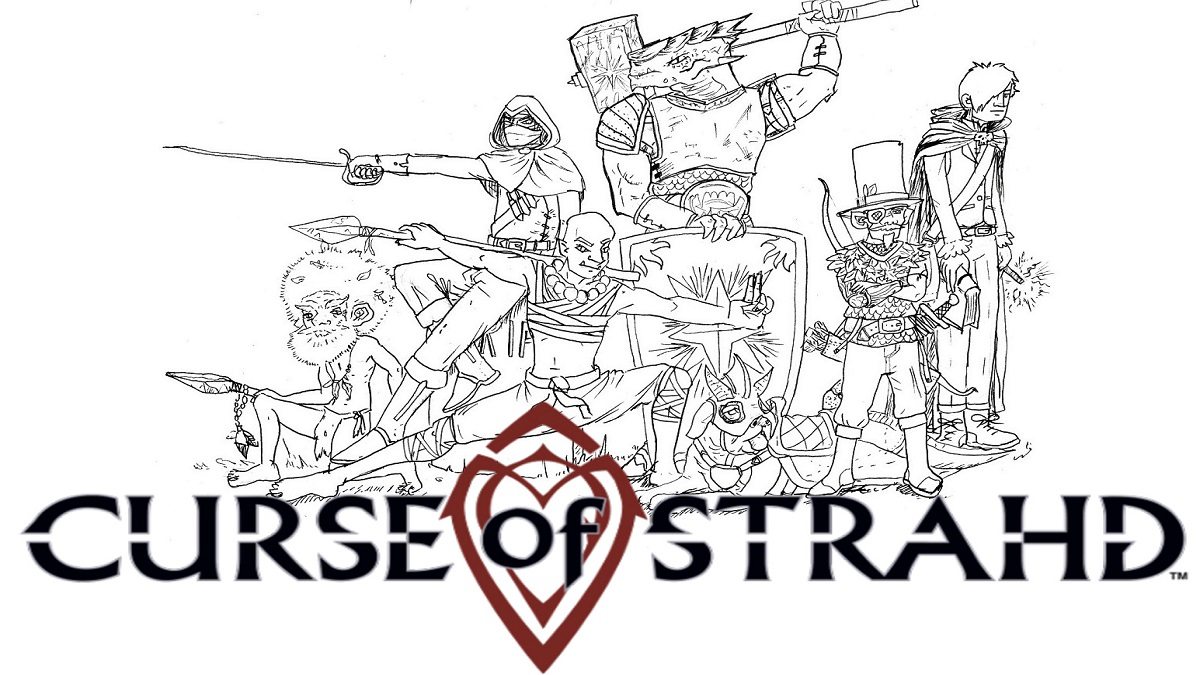
I usually get a lot of outrage from cat lovers when I state my belief that “cats are jerks.” Most back off when I point out that when dogs ruin your stuff, it’s because they’re goofy and playful. When a cat ruins your stuff, it’s usually premeditated.
Ergo, cats are jerks.
A new board game by ThinkFun aims to turn spilled coffee, vanishing goldfish, and tangled yarn into a fun logic puzzle as you figure out which of six cats is to blame. Cat Crimes is built for a single player, so I guess it was designed for that Crazy Cat Lady in your life. However, I found far more enjoyment when playing it with others.

What Is Cat Crimes?
Cat Crimes is a single-player game for ages 8 and up. It currently retails for $12.99 and can fill up only a few minutes of your time, or take a couple hours depending on how many of the Challenge Cards you choose to play through. The game is set around a rectangular game board that looks like a hardwood floor with an oval rug on top. There are six Cat Tokens to be placed around the board, but whose position you must deduce using clues. There are 40 Challenge Cards each with a different “crime” and several clues.
The “crimes” include familiar cat offenses like knocking over a potted plant or eating the pet bird (don’t worry, the game has no gruesome details). There are six places around the board for the Cat Tokens; two spots on each long side and one on each end. Challenge Cards provide clues like, “Ginger was sitting next to the fish bowl,” and “Duchess was sitting to the left of Sassy.”

Cat Crimes Components
The box is smaller than 10″ x 7″ x 2″, so I found it pretty portable for road trips. Here’s what you’ll find inside:
- Game board, appearing as a rug on a hardwood floor
- 6 Cat Tokens (with stands), each with a unique cat character
- 6 Crime Tokens
- 40 numbered Challenge Cards with full solutions of cat placement and ‘whodunit’ on the back
- 10 Beginner level
- 10 Intermediate level
- 10 Advanced level
- 10 Expert level
- 14-page Instruction Manual
The artwork is very cute and approachable for kids. The board, Cat Tokens, and Crime Tokens are made with a heavy-weight cardboard, so they feel durable. Each spot around the board has illustrations that function as evidence; like a toy mouse or scratched floor for identification.
The dimensions of the game board are only 8″ x 5″, but the ‘oval rug’ portion is raised so you need a few inches around each side of the board in order to place the Cat Tokens. If they had more space on the ‘hardwood’ floor to place the Cat Tokens then the game play would probably require an even smaller footprint than it already does. As it stands, you probably need a space at least 11 inches long and 8 inches wide to play (about the size of a sheet of paper). With a play space that size, and a similarly small box, Cat Crimes would be a good game to pack for a road trip or another vacation where you get to enjoy a lot of down-time.
How to Play Cat Crimes
There are forty Challenge Cards, each with their own crime. The first ten are rated Beginner difficulty, with ten more each for Intermediate, Advanced and Expert levels. The cards are also numbered 1-40 and get progressively harder.
The recommended “Ages 8 to Adult” feels appropriate for the solo game. There is a lot of logistical deciphering needed to grasp what is written on each Challenge Card. Nearly half the manual is a section titled, “Interpreting the Clues,” where it clarifies phrasing such as the difference between a cat sitting “in front,” “near,” or “beside” a piece of evidence.
Basic Gameplay (One Player)
Each Challenge Card tells you the crime that’s been committed. First, you place a specified round Crime Token on the game board. For example, if the crime is “who spilled the coffee,” then the spilled coffee cup Crime Token covers up the untouched cup on the game board. Now you have to figure out which cat is sitting in front of the cup.
You read through the clues on the Challenge Card. Some clues are out-of-order. If the clue is that Tom Cat sits across the game board from Duchess, but you don’t yet know where Duchess is placed, then you’ll need to come back to that clue.
Position the Cat Tokens around the board as you interpret the clues. Clues involving “Supporting Evidence” are tricky, as there’s usually two of each on the board. So, “Ginger is in front of a bag of catnip” could be one of two spots where catnip can be found.
Once you have all the cats placed and you’re confident in your solution, flip the Challenge Card and find out if you’re right. The full layout of all cats is included as a picture, so you can see where you might have gone wrong.

The game is designed to be played by only one player ages 8 and up, but my son wanted to try it as soon as it showed up. So we tried playing it together.
Two player (with a 5-year-old)
We completed the ten Beginner crimes and subsequent playthroughs have shown that he grasps the concepts presented in the clues. I found it to be a good exercise even for young children in interpreting vernacular and using logic to solve puzzles. With help and visual examples my son was able to follow the clues and figure out where each cat should go on his own.

3+ Players
The next time we brought it out was with adult guests after dinner. One person read out the clues, while the others worked together and place the cats in their positions.
Playing this way requires a lot of clear communication. Explaining out loud why you believe a cat token belongs in a certain place helps you confirm if your logic is sound. After all, if you can’t explain why Ginger is in front of the goldfish bowl, then maybe he shouldn’t be.
We were also able to test out a few of the more advanced “crimes.” By the end of the game, you will be trying to figure out cat placement from clues like, “Sassy was either sitting across from Tom Cat or in front of a mouse, but not both.” Extremely challenging, but with 40 levels of increasing difficulty there are lots of “crimes” to warm you up.

Why You Should Play Cat Crimes
Forty Challenge cards provides a satisfying amount of replay value. Unless you have an eidetic memory, you’ll probably forget details of each cat’s placement around the board between plays. Still, I’d love to see an app or web site that posts additional challenges and supports an open community to supply more.
Playing on my own, I was able to get well into the Advanced Challenge Cards before getting stumped. However, with no one else around to discuss my logic (besides my cat) I just skipped it and moved on to the next card. Cat Crimes is a unique logic board game designed for single players, but I had far more fun playing it alongside others.
Cat Crimes is currently available on Amazon.com for $12.99 and wherever you buy board games to distract yourself from cleaning up after your cat.
The game supports both casual pick-up-and-play as well as brain-twisting challenges that will have you going over the same clues over and over until you just give up, clean up the mess, and simply accept the truth that cats are jerks.
Click here to see all our tabletop game reviews.
If you’d like to stay up-to-date with all of our tabletop gaming coverage, please copy this link and add it to your RSS reader.
Disclosure: GeekDad received a copy of this game for review purposes.





game is far less entertaining while lacking in playability beyond the 40 cards and def not worth the money. Bought it on geekdads recommendation /review but won’t make same mistake twice.